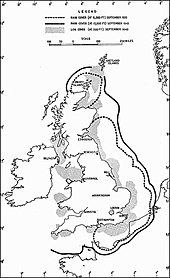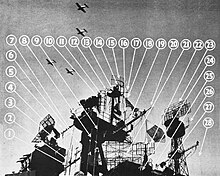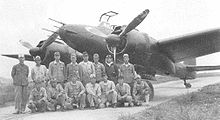Radar in World War II
[1] This revolutionary new technology of radio-based detection and tracking was used by both the Allies and Axis powers in World War II, which had evolved independently in a number of nations during the mid 1930s.
In February 1940, Great Britain developed the resonant-cavity magnetron, capable of producing microwave power in the kilowatt range, opening the path to second-generation radar systems.
[6][7] In addition to Britain, Germany, and the United States, wartime radars were also developed and used by Australia, Canada, France, Italy, Japan, New Zealand, South Africa, the Soviet Union, and Sweden.
Following Watson-Watt's advice, by early 1940, the RAF had built up a layered control organization that efficiently passed information along the chain of command, and was able to track large numbers of aircraft and direct interceptors to them.
Shortly before the outbreak of World War II, several RDF (radar) stations in a system known as Chain Home (or CH) were constructed along the South and East coasts of Britain, based on the successful model at Bawdsey.
Greater disruption was caused by destroying the teletype and landline links of the vulnerable above-ground control huts and the power cables to the masts than by attacking the open latticework towers themselves.
At the end of 1939 when the decision was made to develop 10 cm radar, there were no suitable active devices available - no high power magnetron, no reflex klystron, no proven microwave crystal mixer, and no TR cell.
In the Tizard Mission during September 1940, it was given free to the U.S., along with other inventions, such as jet technology, in exchange for American R&D and production facilities; the British urgently needed to produce the magnetron in large quantities.
When the exchange began, the British were surprised to learn of the development of the U.S. Navy's pulse radar system, the CXAM, which was found to be very similar in capability to their Chain Home technology.
On 7 December 1941 an SCR-270 at Oahu in Hawaii detected the Japanese attack formation at a range of 132 miles (212 km), but this crucial plot was misinterpreted due to a grossly inefficient reporting chain.
The National Defense Research Committee (NDRC), asked Merle Tuve of the Carnegie Institution of Washington to take the lead in realising the concept, that could increase the probability of kill for shells.
The airborne radar system included a television camera to pick up the PPI display, and a VHF link transmitted the image back to the Combat Information Center on the host carrier.
For nighttime detection, the Glavnoye artilleriyskoye upravleniye (GAU, Main Artillery Administration), of the Red Army, had developed an acoustical unit that was used to aim a searchlight at targets.
A RUS-2 system was set up near Moscow and manned by recently moved LPTI personnel; it was first used on July 22, when it detected at night an incoming flight of about 200 German bombers while they were 100 km away.
Within a few weeks, a team led by Mikhail L. Sliozberg and with the cooperation of NII-20, developed a bi-static CW set designated SON (acronym for Stancyja Orudijnoi Navodki Russian: Станция орудийной наводки — Gun Laying Station) using a 15-cm (2.0-GHz) magnetron.
From their intelligence sources, the Soviets were aware of Britain's gun-laying RDF (Range and Direction Finding) system, the GL Mk II, and asked for this equipment to be tested in the defense of Moscow.
Several techniques for replacing the null-reading methods were considered, with the final selection making use of a fixture to provide a stationary dipole against which the directional position of the antenna could be continuously determined.
In 1904, Christian Hülsmeyer obtained German and foreign patents for an apparatus, the Telemobilskop, using a spark gap transmitter that could detect ships and prevent collisions; this is often cited as the first radar, but, without directly providing range, it does not qualify for this classification.
In 1933, physicist Rudolf Kühnhold, Scientific Director at the Kriegsmarine (German Navy) Nachrichtenmittel-Versuchsanstalt (NVA) (Signals Research Establishment) in Kiel, initiated experiments in the microwave region to measure the distance to a target.
To a large part, this was due to the lack of appreciation of this technology by the military hierarchy, especially at the top where dictator Adolf Hitler looked on radar as a defensive weapon, and his interest was in offensive hardware.
The Matratze (mattress) antenna array in its full form had sixteen dipoles with reflectors (a total of 32 elements), giving a wide searching field and a typical 4-km maximum range (limited by ground clutter and dependent on altitude), but producing a great deal of aerodynamic drag.
[40] The first radar prototypes in Italy were developed as early as 1935 by electronics researcher Ugo Tiberio who, after graduating in 1927 from the Royal School of Engineering in Naples, published some papers on electromagnetism and, during his military service, was posted to the Military Communications Institute in Rome where Colonel Luigi Sacco - after having observed some experiments made by Guglielmo Marconi on the reflection of radio waves - gave him the task to verify whether these properties of radio waves could be used to find the location of distant objects.
[41] Notwithstanding their achievement, conducted under the supervision of Navy Captain Alfeo Brandimarte, the project was stalled due to the lack of funding and resources, as both Tiberi and Carrara had to attend their teaching duties and could only do research in their spare time.
[44] The radar was used in combat by the light cruiser Scipione Africano on the night of 17 July 1943, while on passage from La Spezia to Taranto,[45][46] when she detected a flotilla of four British Elco motor torpedo boats five miles ahead in the strait of Messina.
[47] After Italy's armistice in September 1943, all the documentation pertaining to the research and development of the "Gufo" and of its ground-based version, named "Folaga" (coot) and built by Radiomarelli, was destroyed by order of the Italian Royal Navy Command to prevent it from falling in the hands of the occupying Nazi troops.
When war with Germany was believed to be inevitable, Great Britain shared its secrets of RDF (radar) with the Commonwealth dominions of Australia, Canada, New Zealand, and South Africa – and asked that they develop their own capabilities for indigenous systems.
From this, the LW/AW Mark II resulted; about 130 of these air-transportable sets were built and used by the United States and Australian military forces in the early island landings in the South Pacific, as well as by the British in Burma.
In September 1940, on their trip to the United States for cooperative exchanges, the Tizard Mission visited Canada and recommended that Great Britain use Canadian personnel and facilities to supplement the British programs.
In late 1939, the New Zealand Department of Scientific and Industrial Research (DSIR) established two facilities for RDF development – one, led by Charles Watson and George Munro (Watson-Munro) was at the Radio Section of the Central NZ Post Office in Wellington, and the other, under the responsibility of Frederick White, was at Canterbury University College in Christchurch.
This was then improved to become the 430 MHz (70 cm) SWG (Ship Warning, Gunnery), and in August 1941 went into service on the Archilles and Leander, Cruisers transferred to the newly formed Royal New Zealand Navy (RNZN).














